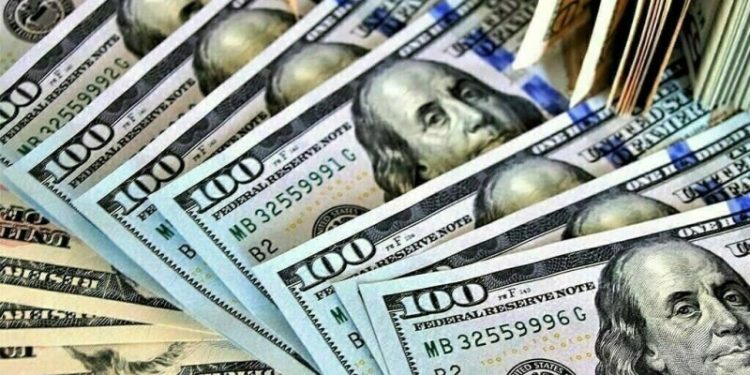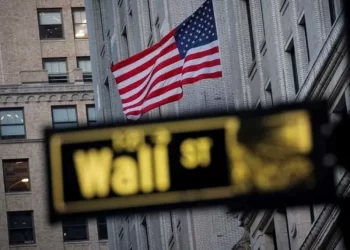SINGAPORE: The safe havens yen and Swiss franc held near six-month highs on Tuesday while the US dollar nursed broad losses as financial markets grappled with mounting recession worries in the wake of President Donald Trump’s sweeping tariffs.
The currency markets were fragile but eerily calm in Asian trade after a volatile 24-hour period where the dollar reversed heavy losses against the safe haven currencies as traders took stock of the risk of a rapidly escalating trade war.
Global shares have plummeted since Trump announced tariffs last week.
China and the European Union swiftly hit back by proposing higher tariffs of their own, which Trump in turn threatened to fight with even higher duties.
In currencies, investors have flocked to the Japanese yen and Swiss franc in the past week, seeking shelter from the market turmoil in traditional safe havens.
The yen was last slightly stronger at 147.325 per dollar, near the six-month high of 144.82 touched on Friday.
The Swiss franc last fetched 0.85665 per US dollar, also near a six-month high touched in the previous session.
While the dollar is typically known as a safe-haven asset, that status seems to be eroding as uncertainty over tariffs and concern over their impact on US growth intensify.
The euro rose 0.58% to $1.0967, not far from the six-month high it hit last week, while sterling was 0.44% higher at $1.27795, inching away from the one-month low it touched in the previous session.
“The current volatility is entirely the result of the policy choices of the Trump administration, meaning that if reversed, the impact on financial markets will likely reverse as well,” said Nathan Lim, chief investment officer at Lonsec Investment Solutions.
Investors are wagering that the rising risk of an economic downturn could lead to a cut in US interest rates as early as May and with more easing priced in this year, that would erode the dollar’s yield advantage.
The dollar index, which measures the US currencies against six other units, was 0.44% lower on Tuesday.
US dollar higher
The index is down over 1% since the tariffs were announced last week.
Chicago Federal Reserve Bank President Austan Goolsbee on Monday said while businesses are anxious about the tariffs, the central bank would need to look at “hard data” in its policy response.
Kevin Gordon, senior investment strategist at Charles Schwab, said the Fed is still constrained from acting by relatively sticky inflation.
“I don’t see how or why aggressive rate cuts by the Fed would solve this, however, or where we get the kind of monetary or fiscal stimulus that typically arrives on the scene halfway through or toward the end of a bear market.”
The risk-sensitive Australian and New Zealand dollars have dropped against their US counterpart in the past week.
The Aussie was 0.6% stronger at $0.6025, but hovering close to the five-year low it touched on Monday.
The kiwi rose 0.45% to $0.5575 ahead of a policy meeting on Wednesday, where New Zealand’s central bank is expected to cut rates.
China’s yuan fell to its weakest level since 2023 after the central bank slightly loosened its grip on the currency in what analysts said was an attempt counteract the blow to exports from an intensifying trade war.
James Athey, fixed income manager at Marlborough, said people are still hopeful that the most punitive tariffs can be negotiated down but noted that there are still downside risks.
“How and where we end are going to be a function of tariff negotiations, key economic data and central bank responses.
If defensive equity sectors start to underperform that will suggest we’ve moved into sell everything mode.“
SINGAPORE: The safe havens yen and Swiss franc held near six-month highs on Tuesday while the US dollar nursed broad losses as financial markets grappled with mounting recession worries in the wake of President Donald Trump’s sweeping tariffs.
The currency markets were fragile but eerily calm in Asian trade after a volatile 24-hour period where the dollar reversed heavy losses against the safe haven currencies as traders took stock of the risk of a rapidly escalating trade war.
Global shares have plummeted since Trump announced tariffs last week.
China and the European Union swiftly hit back by proposing higher tariffs of their own, which Trump in turn threatened to fight with even higher duties.
In currencies, investors have flocked to the Japanese yen and Swiss franc in the past week, seeking shelter from the market turmoil in traditional safe havens.
The yen was last slightly stronger at 147.325 per dollar, near the six-month high of 144.82 touched on Friday.
The Swiss franc last fetched 0.85665 per US dollar, also near a six-month high touched in the previous session.
While the dollar is typically known as a safe-haven asset, that status seems to be eroding as uncertainty over tariffs and concern over their impact on US growth intensify.
The euro rose 0.58% to $1.0967, not far from the six-month high it hit last week, while sterling was 0.44% higher at $1.27795, inching away from the one-month low it touched in the previous session.
“The current volatility is entirely the result of the policy choices of the Trump administration, meaning that if reversed, the impact on financial markets will likely reverse as well,” said Nathan Lim, chief investment officer at Lonsec Investment Solutions.
Investors are wagering that the rising risk of an economic downturn could lead to a cut in US interest rates as early as May and with more easing priced in this year, that would erode the dollar’s yield advantage.
The dollar index, which measures the US currencies against six other units, was 0.44% lower on Tuesday.
US dollar higher
The index is down over 1% since the tariffs were announced last week.
Chicago Federal Reserve Bank President Austan Goolsbee on Monday said while businesses are anxious about the tariffs, the central bank would need to look at “hard data” in its policy response.
Kevin Gordon, senior investment strategist at Charles Schwab, said the Fed is still constrained from acting by relatively sticky inflation.
“I don’t see how or why aggressive rate cuts by the Fed would solve this, however, or where we get the kind of monetary or fiscal stimulus that typically arrives on the scene halfway through or toward the end of a bear market.”
The risk-sensitive Australian and New Zealand dollars have dropped against their US counterpart in the past week.
The Aussie was 0.6% stronger at $0.6025, but hovering close to the five-year low it touched on Monday.
The kiwi rose 0.45% to $0.5575 ahead of a policy meeting on Wednesday, where New Zealand’s central bank is expected to cut rates.
China’s yuan fell to its weakest level since 2023 after the central bank slightly loosened its grip on the currency in what analysts said was an attempt counteract the blow to exports from an intensifying trade war.
James Athey, fixed income manager at Marlborough, said people are still hopeful that the most punitive tariffs can be negotiated down but noted that there are still downside risks.
“How and where we end are going to be a function of tariff negotiations, key economic data and central bank responses.
If defensive equity sectors start to underperform that will suggest we’ve moved into sell everything mode.“









